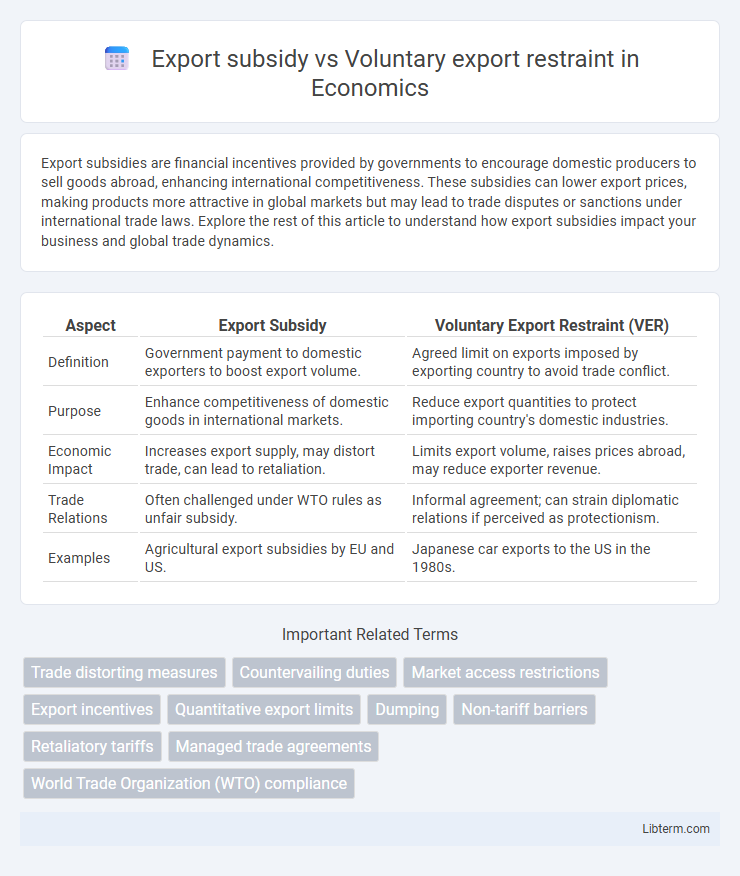Export subsidies are financial incentives provided by governments to encourage domestic producers to sell goods abroad, enhancing international competitiveness. These subsidies can lower export prices, making products more attractive in global markets but may lead to trade disputes or sanctions under international trade laws. Explore the rest of this article to understand how export subsidies impact your business and global trade dynamics.
Table of Comparison
| Aspect | Export Subsidy | Voluntary Export Restraint (VER) |
|---|---|---|
| Definition | Government payment to domestic exporters to boost export volume. | Agreed limit on exports imposed by exporting country to avoid trade conflict. |
| Purpose | Enhance competitiveness of domestic goods in international markets. | Reduce export quantities to protect importing country's domestic industries. |
| Economic Impact | Increases export supply, may distort trade, can lead to retaliation. | Limits export volume, raises prices abroad, may reduce exporter revenue. |
| Trade Relations | Often challenged under WTO rules as unfair subsidy. | Informal agreement; can strain diplomatic relations if perceived as protectionism. |
| Examples | Agricultural export subsidies by EU and US. | Japanese car exports to the US in the 1980s. |
Introduction to Export Subsidy and Voluntary Export Restraint
Export subsidies are government financial supports provided to domestic producers to encourage exports by making their goods more competitive in international markets. Voluntary export restraints (VERs) are trade limits imposed by an exporting country, often negotiated with the importing country, to restrict the quantity of goods exported. Both measures influence international trade flows but differ in implementation--export subsidies actively promote exports through financial incentives, while VERs cap export volumes to manage trade relations.
Defining Export Subsidy: Meaning and Mechanisms
Export subsidy is a government financial support aimed at promoting domestic goods in international markets by lowering production costs or offering direct payments to exporters. This mechanism enhances export competitiveness, often leading to increased market share and reduced prices abroad. Unlike voluntary export restraint, which is a self-imposed limitation by exporting countries, export subsidies are proactive fiscal policies designed to stimulate export volumes and improve trade balances.
Understanding Voluntary Export Restraint (VER)
Voluntary Export Restraint (VER) is a trade restriction where an exporting country agrees to limit the quantity of goods exported to a particular importing country, often to avoid stricter trade barriers or tariffs. Unlike export subsidies, which provide financial incentives to increase exports, VERs are quotas negotiated between governments to protect domestic industries from foreign competition. Understanding VERs is crucial as they can lead to higher prices for consumers and strained international trade relations.
Key Differences Between Export Subsidies and VERs
Export subsidies are government financial incentives aimed at boosting domestic producers by lowering export costs, whereas Voluntary Export Restraints (VERs) are self-imposed limits by exporting countries on the quantity of goods exported to another country. Export subsidies increase export competitiveness through monetary support, while VERs restrict market access to protect the importing country's industries without altering price competitiveness. Key differences lie in their mechanisms: subsidies involve direct financial aid, whereas VERs involve negotiated export quantity limits.
Economic Impact of Export Subsidies
Export subsidies lower the cost of domestically produced goods in international markets, enhancing export competitiveness and increasing market share for exporters. This government financial support can distort trade by encouraging overproduction, leading to inefficiencies and potential retaliatory measures from trading partners. While export subsidies stimulate short-term economic growth and employment, they may provoke trade tensions, harming global market equilibrium and causing resource misallocation.
Economic Consequences of Voluntary Export Restraints
Voluntary export restraints (VERs) often lead to higher prices and restricted supply in the importing country, reducing consumer welfare and creating deadweight losses in the market. Unlike export subsidies, which encourage increased exports and can distort global trade patterns, VERs limit export volumes directly, potentially provoking retaliatory trade measures and market inefficiencies. The economic consequences of VERs include supply chain disruptions, reduced competition, and shifts in production that can harm long-term trade relations and economic growth.
Export Subsidy: Advantages and Disadvantages
Export subsidies provide domestic producers with financial support to increase international competitiveness, boosting export volumes and promoting economic growth. However, these subsidies can lead to market distortions, trade tensions, and retaliatory measures from trading partners under World Trade Organization (WTO) rules. The financial burden on government budgets and potential inefficiencies in resource allocation are significant disadvantages of maintaining export subsidies.
Pros and Cons of Voluntary Export Restraints
Voluntary export restraints (VERs) limit the quantity of goods exported to a specific country, helping protect the importing nation's domestic industries and preventing trade disputes. However, VERs can lead to higher prices for consumers, reduced export revenues for the exporting country, and potential retaliation by trade partners. Unlike export subsidies, which provide direct financial support to exporters, VERs rely on voluntary agreements, often resulting in less transparent and less efficient market outcomes.
Case Studies: Real-World Examples and Applications
Export subsidies, used by countries like China in the early 2000s to boost steel and solar panel exports, lower production costs and enhance global competitiveness but often trigger disputes at the World Trade Organization (WTO). Voluntary export restraints (VERs) applied by Japan in the 1980s to limit automobile exports to the United States helped ease trade tensions but led to higher car prices and shifts in manufacturing locations. These case studies illustrate how export subsidies and VERs impact international trade dynamics by protecting domestic industries while inviting regulatory scrutiny and market adjustments.
Policy Considerations and Global Trade Implications
Export subsidies distort international markets by artificially lowering export prices, leading to retaliatory tariffs and trade disputes under World Trade Organization (WTO) rules. Voluntary export restraints (VERs) function as negotiated limits on exports to avoid more severe trade restrictions, often resulting in supply shortages and higher prices for importing countries. Both policies can provoke inefficiencies and reduce global welfare by disrupting comparative advantage and harming third-party trading partners.
Export subsidy Infographic

 libterm.com
libterm.com